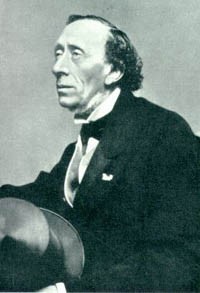Hans Christian Andersen (Hans Christian Andersen)

Writer. Famous for his fairy tales. His father was a poor shoemaker and literate, who believed he was of aristocratic origin. Andersen’s mother worked as washerwoman. He declined into alcoholism and died in 1833 in a charitable old people’s home. Andersen’s half-sister Karen Marie worked as a prostitute for some time. She contacted her famous brother only a few times before dying in 1846. Andersen received little education. As a child he was highly emotional, suffering all kinds of fears and humiliations because of his tallness and effeminate interests. Encouraged by his parents he composed his own fairy tales and arrange puppet theatre shows. His father loved literature and took Andersen often to the playhouse. In 1816 his father died and Andersen was forced to go to work. He was for a short time apprenticed to a weaver and tailor, and he also worked at a tobacco factory. At the age of 14 Andersen moved to Copenhagen to start a career as a singer, dancer or an actor – he had a beautiful soprano voice. Andersen succeeded in becoming associated with the Royal Theater, but he had to leave it when his voice began to change. He then began to write plays, all of which were rejected. In 1822 Jonas Collin, one of the directors of the Royal Theatre gave Andersen a grant to enter the grammar school at Slagelse. Collin arranged in 1827 a private tuition for Andersen. He gained admission to Copenhagen University, where he completed his education. Andersen’s poem “The Dying Child”, was published in a Copenhagen journal and the Royal Theatre produced in 1829 his musical drama. From 1831 he traveled widely in Europe, and remained a passionate traveler all his life. Andersen wrote sketches about Sweden, Spain, Italy, Portugal, and the Middle East. During his journeys Andersen met in Paris among others Victor Hugo, Heinrich Heine, Balzac, and Alexandre Dumas. A “Poet’s Day Dreams” in 1853 he dedicated to Charles Dickens, whom he met in London in 1847. As a novelist he made his breakthrough with “The Improvisatore” in 1835. Andersen’s fame rests on his “Fairy Tales and Stories”, written between 1835 and 1872. “Tales, Told for Children”, appeared in a small, cheap booklet in 1835. In this and following early collections, which were published in every Christmas, he returned to the stories which he had heard as a child, but gradually he started to create his own tales. The third volume, published in 1837, contained “The Little Mermaid” and “The Emperor’s New Clothes”. Among Andersen’s other best known tales are “Little Ugly Duckling”, “The Tinderbox”, “Little Claus and Big Claus”, “Princess and the Pea”, “The Snow Queen”, “The Nightingale” and “The Steadfast Tin Soldier”. With these collections he became known as the father of the modern fairytale. Between the years 1840 and 1857 he made journeys throughout Europe, Asia Minor, and Africa, recording his impressions and adventures in a number of travel books. He wrote his memoirs, “The Fairy Tale of My Life”. Andersen never married. (bio by: Jelena)
Born
- April, 02, 1805
- Denmark
Died
- August, 08, 1875
- Denmark
Cemetery
- Assistens Cemetery
- Hovedstaden
- Denmark

